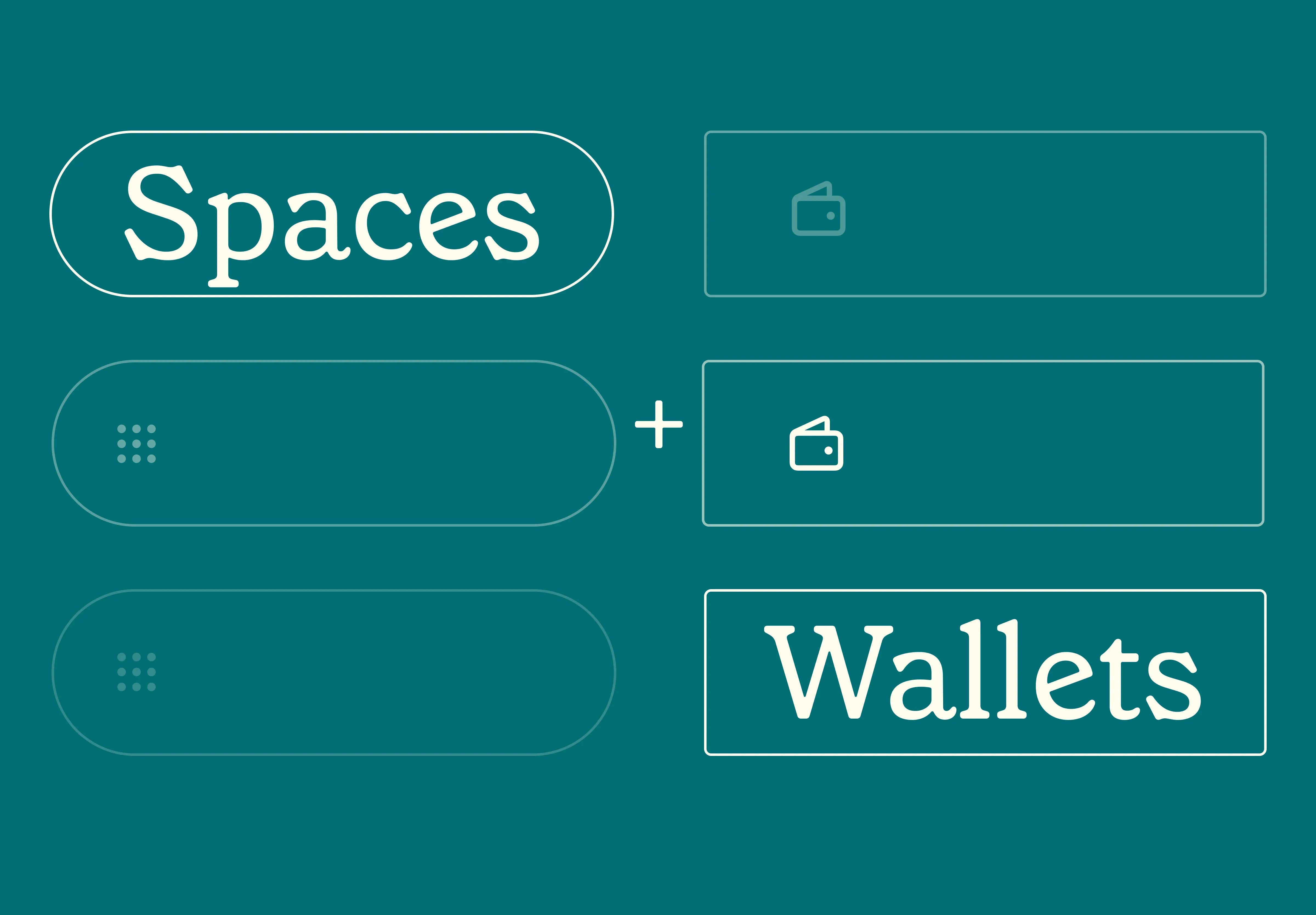14 Nov 2025
|16 min
What are user interviews?
Learn about the importance of user interviews in UX research, how to conduct them effectively, and how to leverage insights to design products that meet real user needs.

They say a picture is worth a thousand words, but in the field of user experience research, a quote is worth a thousand data points. While quantitative data shows how users interact with a product or service, qualitative feedback – especially in the form of users’ real words – adds unique context. Good UX is all about understanding the audience’s problems and offering solutions, but it’s hard to empathize with numbers alone.
That’s where user interviews come in. Speaking with real people not only gives you valuable information, but also creates a deeper understanding of user behaviors, beliefs, and needs, something that’s central to many qualitative methods of research.
Whether conducted at scale to help create user personas or as a one-off exercise to address a specific issue, user interviews play a vital role in designing products that genuinely resonate with people.
In this article, we’ll explore what user interviews are and how to execute them effectively.

The role of user interviews in research
User interviews are a way to get qualitative data. They involve talking to real or representative users of your product or service in real time. Real users are people who already use the product or service, whereas representative users are people who fit the demographic or behavior profiles of the product or service's desired user base.
Here are some of the reasons why interviews are valuable:
In-depth learning: Interviews allow you to gather rich, detailed information from participants. They provide a deep understanding of their experiences, perspectives, and emotions.
Contextual understanding: Interviews can uncover the context in which participants' thoughts and actions are embedded. This is often hard to capture through surveys or quantitative data alone.
Flexibility: The flexibility interviews provide enables you to adapt your approach based on the evolving needs of your study. This allows for exploration of unanticipated themes and the addition or omission of interview questions in real time.
Gives users a voice: Interviews give participants a chance to share their stories and experiences. This makes them feel heard and valued in the research process. You also gain an understanding from hearing the words, phrases, and descriptors they use in their responses.
When to conduct user interviews in research

User interviews are a simple and inexpensive way to get useful information. Although there are helpful tools, all user interviews really need is a moderator, a participant, and some recording equipment. For this reason, they’re a sensible pick for many phases of the research process. However, they’re most often used in the following contexts.
Exploratory research
User interviews can be done as part of research to better understand users' experiences, preferences, and behaviors. This can be helpful when entering new markets, developing new products, or targeting specific user segments.
For example, you could conduct semi-structured interviews (more on this soon) with potential users to explore their needs, challenges, and expectations before developing a new product. You can gather insights that shape the initial direction of the project.
Exploring complex topics
When your research involves complex topics, user interviews can provide a deeper understanding of these intricacies. They can help unravel the layers of a subject.
For example, you might be looking into a new technology within a specific industry. By talking to experts, you can learn about the small things that make people use that technology.
Contextual research
If you need to study a topic within a specific context, user interviews are the go-to method. They can offer insights into how external factors affect the subject of your study.
For example, you might study the usability of a coffee maker by interviewing participants in their homes. This approach can help you understand how external factors, such as the user's surroundings and daily routines, can impact their interactions with the product.
Validation and confirmation
User interviews are valuable for confirming and validating findings from other research methods, such as surveys or prototype tests. They complement different types of quantitative analysis by adding the context needed to understand the “why” behind the data, something that becomes clearer when you understand the pros and cons of qualitative and quantitative research.
For example, user interviews can be used as part of usability testing to observe how users interact with a product or prototype. This allows for real-time feedback and an understanding of usability issues.
In-depth exploration
When your research aims to explore individual experiences, emotions, or perspectives, in-depth interviews are an ideal choice. They allow participants to express themselves freely.
For example, if you're researching the process of applying for college scholarships, in-depth interviews can uncover individual experiences, allowing for a nuanced understanding of the challenges and support needed during this journey.
Product iterations
User interviews can also be conducted to collect feedback throughout the product development process and during continuous product discovery. This iterative approach helps you refine your product in real-time.
Pro tip: When researching global markets, don't let language limit your insights. Lyssna supports interviews in 30 languages (in addition to English), with fully localized communications for participants. This lets you include diverse perspectives worldwide and gather more authentic feedback from users expressing themselves in their native language.
Types of user interviews
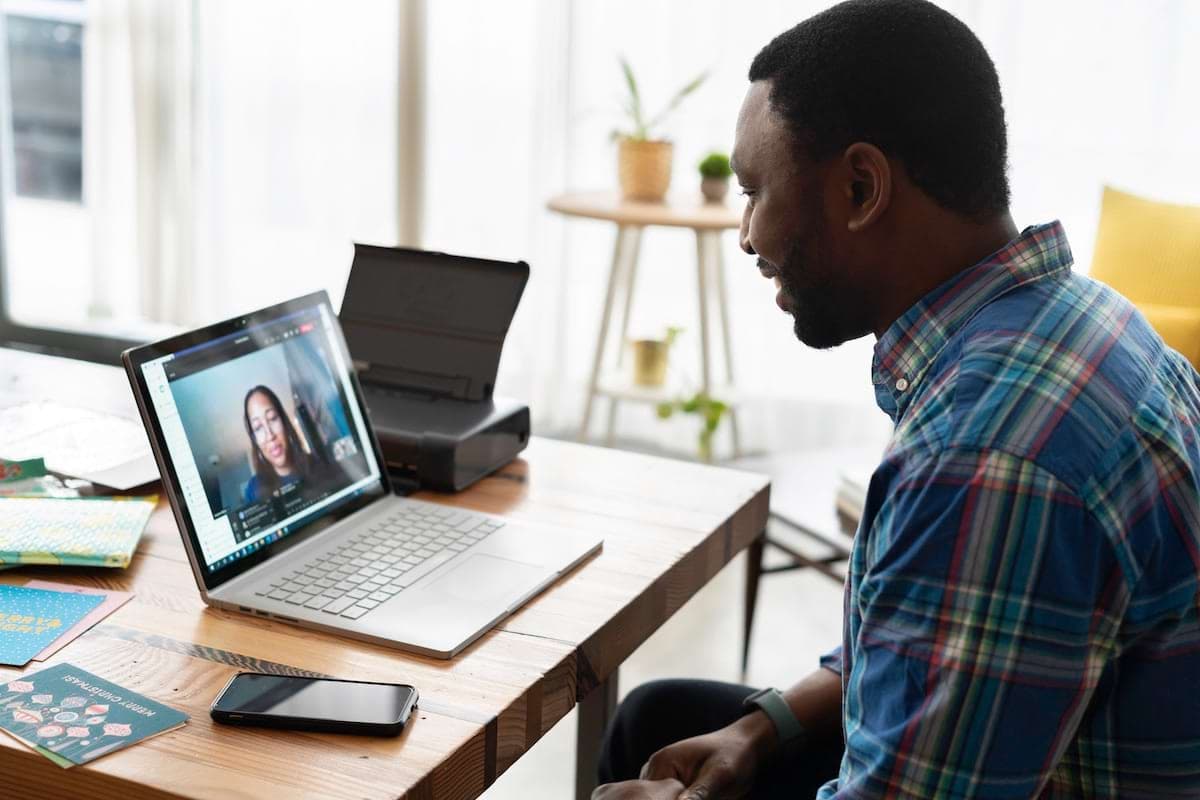
User interviews are basically the same – a moderator asks participants questions. But there are a few different ways to do them.
The first relates to the structure of the interview:
Structured
Semi-structured
Unstructured
The next relates to the purpose of the interview:
Generative
Contextual
Continuous
And the last relates to the location of the interview:
Remote
In-person
Let’s look at each of these user interview types in more detail.
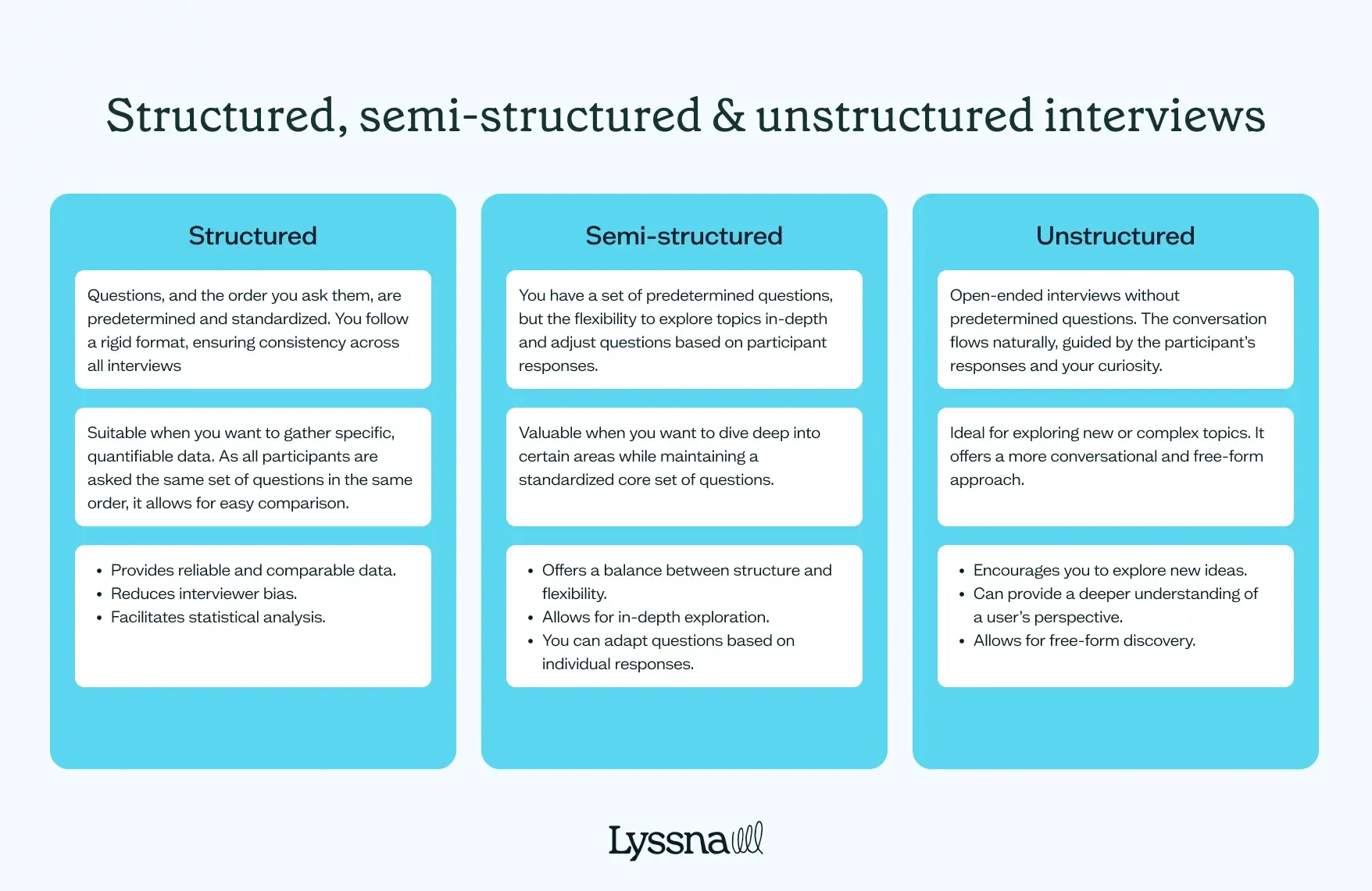
Structured interviews
Description: In structured interviews, the questions and the order you ask them are predetermined and standardized. Like surveys, you follow a rigid format, ensuring consistency across all interviews.
Purpose: This method is suitable when you want to gather specific, quantifiable data, such as time on task. It makes it easy to compare responses because all participants are asked the same questions in the same order.
Advantages:
Provides reliable and comparable data.
Reduces interviewer bias.
Facilitates statistical analysis.
Semi-structured interviews
Description: Semi-structured interviews have a set of predetermined questions, but the moderator has the flexibility to explore topics in-depth and adjust the questioning based on participant responses.
Purpose: Semi-structured interviews are useful when you want to explore certain areas while keeping a set of basic questions.
Advantages:
Offers a balance between structure and flexibility.
Allows for in-depth exploration.
You can adapt questions based on individual responses.
Unstructured interviews
Description: Unstructured interviews are open-ended and lack a predetermined set of questions. The conversation flows naturally, guided by the participant's responses and your curiosity.
Purpose: Ideal for exploring new or complex topics where you want to discover unexpected learning. It offers a more conversational and free-form approach.
Advantages:
Encourages exploration of new ideas in an “anything goes” sort of way.
May provide a deeper understanding of participants' perspectives.
Allows for more free-form discovery.
Generative interviews
Generative interviews are often used in the early stages of research to uncover new ideas and user needs. They fall under the broader category of generative vs evaluative research, where the focus is on discovery rather than validation. These interviews aim to explore users' experiences, preferences, and aspirations through open-ended questions that encourage creative thinking.
These interviews are commonly used in the early stages of product development or when exploring new opportunities.
Contextual interviews
Contextual interviews are conducted in a participant's natural environment or context, such as their home or workplace. (If you’re designing a cooking app, for example, observing people in their home kitchens could be invaluable.)
Contextual interviews give us important information about how users navigate their environments and help us find ways to improve them.
Continuous interviews
Continuous interviews involve conducting interviews with participants over an extended period of time. This longitudinal approach allows you to gather insights and observe changes in participants' behaviors or attitudes over time. Continuous interviews can be helpful for tracking the effects of actions or using new products or services. They give a long-term view that one-time interviews may not show.
Remote interviews
Remote interviews are done with the interviewer and interviewee in different places. They usually use video conferencing or other online tools to talk to each other, making them a popular method for conducting remote user research. This lets participants and interviewers talk without being in the same place.
Remote interviews offer convenience, flexibility, and the ability to reach participants in different locations.
In-person interviews
In-person interviews are done in person, where the interviewer and participant are in the same place. They provide additional opportunities to notice non-verbal cues, a more personal connection, and the ability to observe participants' body language.
User interviews vs user testing vs focus groups
User interviews are like focus groups, but they have only one person answering questions. In a focus group, the presence of additional participants changes the dynamic dramatically: ideas are proposed and countered, a consensus can develop, and people can influence each other. A user interview, on the other hand, is entirely about better understanding one individual’s subjective experience.
It’s also worth distinguishing between user interviews and user testing. In user testing, you observe the user while they interact with a product or service, often sitting behind them and taking notes. You encourage the user to narrate their actions and what they’re noticing, but in general your presence is minimized so that the user can operate without being directed one way or the other. This provides clearer information about how the particular user interacts with the product being tested.
User interviews, on the other hand, are heavily interactive. As the interviewer, you’re encouraged to build rapport with the interviewee, and they’re often conducted before a product has even been designed.
Elevate your research practice
Join over 320,000+ marketers, designers, researchers, and product leaders who use Lyssna to make data-driven decisions.
How to conduct user interviews
Ready to get started with user interviews? In many ways, conducting interviews is a straightforward and fairly logical process. Let’s consider three phases: before, during, and after the interview.
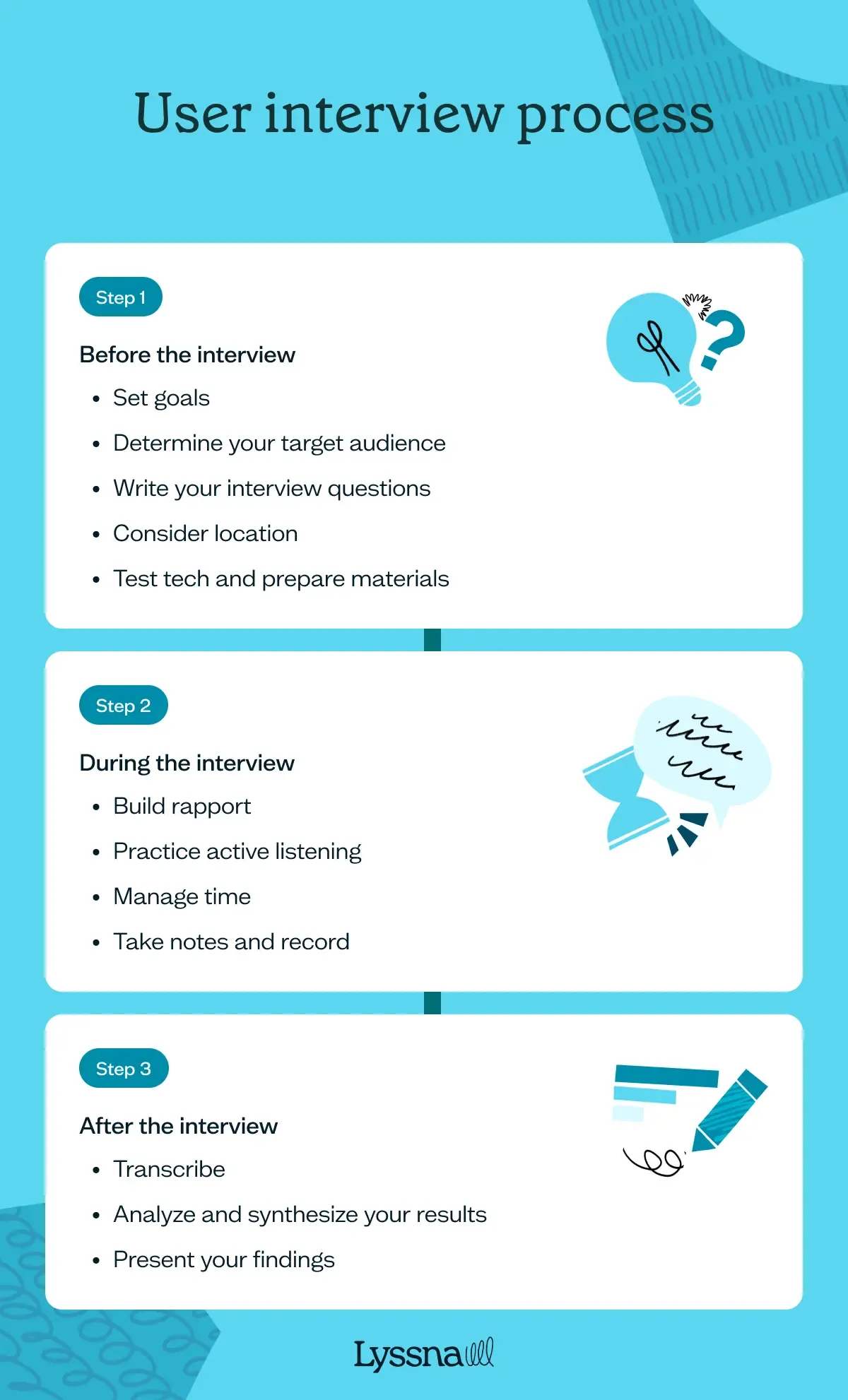
Before the interview
1. Set goals
Check in with other stakeholders to set a clear intention for the interviews. Is it to generate ideas for new features for an existing product? Would you like feedback on a prototype? Are you hoping to understand some of the problems and possible use-cases with a specific audience? The more specific you can make this goal, the better.
2. Determine your target audience
A random sampling of users may be useful in generating broad-scale feedback. However, if the interview is to learn more about a very specific group of people – like young women who work in big cities – that will change how you should find interviewees.
Read more: Check out our guide on identifying your target audience and recruiting participants.
3. Write your interview questions
If you’re doing a structured or semi-structured interview, the next step will be writing questions. For a structured interview, you should phrase these very carefully. The goal of a structured interview is to make the interview experience as standardized as possible. With a semi-structured interview, it can be helpful to write clusters of questions around individual topics. Consider putting questions that are more important in bold, or otherwise marking that they're important and should be included in the interview.
Use our research discussion guide template to help plan your next user interview study.
4. Consider location
Interviewing in your own office can bias the user to be more favorable, whereas interviewing them in their own environment can yield insights about how they go about their day-to-day tasks.
For remote interviews, consider your background and presentation, and additionally whether there are any requirements about where the user should be.
Read more: Check out our recommendations for the top online interview scheduling tools to make organizing user interviews easier.
5. Test tech and prepare materials
Every interviewer's worst nightmare is doing a full user interview and finding out that it didn't go well for any reason. The recording technology didn't work, the follow-up questions didn't work, etc. Before sitting down with the user, double-check all technology and tools are working as expected.
During the interview
1. Build rapport
While it’s not your goal to become the user’s friend, building some rapport by making light small talk can help them open up. Start with a few simple questions – like what they did that day – to get them talking. Tell them a little about yourself to make it less formal.
2. Practice active listening
Make eye contact, nod at answers, and provide light verbal affirmation that you understand and empathize with their responses. Don't interrupt interviewees and let yourself get used to silence, as these can be times when they're thinking about something new.
3. Manage time
Make sure you’re getting to all of your questions in the time allotted. This is especially important in a semi-structured interview, where some questions may be important but you can encourage other ideas.
4. Take notes and record
Automated recordings are helpful, but make sure to write down notes during the interview too. These notes should include interviewee behavior and areas you may want to talk about again. It might be helpful to invite an observer to sit in on interviews and assign them the role of note-taker.
After the interview
1. Transcribe
Automated transcriptions are common now, but if they aren't available, listen to the recording and write down notes and direct quotes. Keep all of these notes organized. In interviews that are structured or semi-structured, where many interviews answer the same questions, a spreadsheet can be helpful.
Read more: Check out the best UX research tools to help you streamline your work.
2. Analyze and synthesize your results
After all the interviews have been transcribed and organized, read through everything to identify patterns. Is the sign-up process particularly onerous for new users? Has a potential new audience segment revealed a particular branding preference? Highlight all of these findings and consider applying ux research synthesis methods to structure and refine these insights effectively..
3. Present your findings
Go back to the original goal and extract the most relevant insights. If users were testing a prototype, this may be divided into big positives (“Users loved the search function”) and negatives (“Users found the layout busy”). If this is a more exploratory project, it could be showing problems potential users need you to fix (“Shopping for ingredients stops users from trying complicated recipes”). And if this an ongoing, longitudinal interview, it could be a recent trend (“Longtime users find the app isn’t updated enough”).
Put all of these findings in whatever format is appropriate for your colleagues – perhaps a one-page brief or a presentation – and deliver the goods.
Organize user interviews with Lyssna

Interviewing is a skill like any other: it gets easier with repetition. Some people are naturals and occupy the “interviewer” role easily, while others take a few goes to get used to it. Eventually, you’ll find your interviewing style. This is a useful skill for teams and worth learning. The information and rewards from these conversations can be used in many projects.
At Lyssna, we enjoy helping our customers conduct remote tests and gather valuable feedback to improve user experiences.
That's where our user interviews feature can help. We know how important it is to make things easier and have all the user research tools you need in one place.
We also have solutions that support you throughout your software development life cycle.
We'd love for you to try it out. Don't have an account? Sign up for free.
Your go-to user research platform
The best teams use Lyssna so they can deeply understand their audience and move in the right direction — faster.
Frequently asked questions about user interviews
You may also like these articles
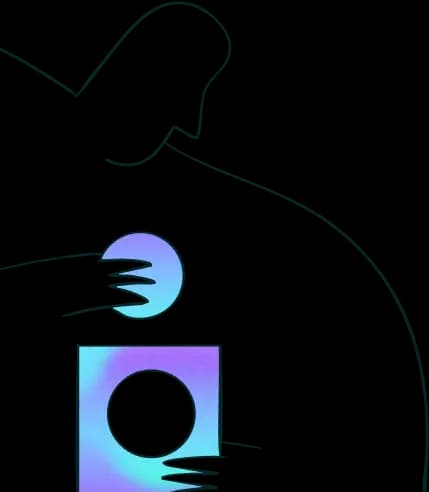

Try for free today
Join over 320,000+ marketers, designers, researchers, and product leaders who use Lyssna to make data-driven decisions.
No credit card required





